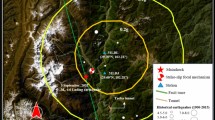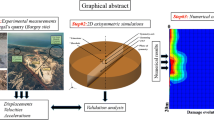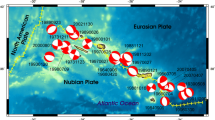Abstract
To evaluate tunnel ground vibrations induced by fault-slip in underground mine, it is crucial to resolve the peak ground velocity (PGV) and the peak ground acceleration (PGA). To quantify PGV and PGA in three-dimensional space, the forces acting on the fault and the seismic wave radiation pattern were investigated. A qualitative method for ground vibration of tunnels induced by fault-slip in underground mine was proposed and applied to the Yongshaba Phosphate Mine, China. Firstly, the moment tensor of the significant fault-slip event was obtained using a full waveform source inversion method based on the recorded seismograms. It describes the forces acting on the fault and the seismic wave radiation pattern. Then, the inverted source was used as a reference to evaluate the ground vibrations under possible larger seismic magnitudes and probable slip models. The vibrations along the tunnels resulted from different slip models were calculated using the representation theorem by the convolution of the Green’s function and the corresponding moment tensor. The velocity series and the acceleration series were obtained. Results show that the spatial distribution of the ground motions are closely related to sensor-source distance, the sensor-source azimuth, as well as the strike, dip, and rake configuration of the slip model. The seismic magnitude has an exponential effect on the distribution of the PGVs and PGAs. The PGV and PGA have similar spatial distribution patterns. The PGV values of the north and vertical components show nearly 5 times higher than the east component. The vertical vibrations affect the widest area. The ground support principles were suggested considering the parameters including the PGVs, the PGAs, the rock mass rating, and the dynamic loads.













Similar content being viewed by others
Abbreviations
- PGV:
-
Peak ground velocity (\(m/s\))
- PGA:
-
Peak ground acceleration (\({\text{m}}/{{\text{s}}^2}\))
- MT:
-
Moment tensor
- MTI:
-
Moment tensor inversion
- \(\alpha\) :
-
Strike of the fault plane, defined as the angle from North
- \(\beta\) :
-
Dip of the fault plane, defined as the angle from the horizontal
- \(\lambda\) :
-
Rake of the fault plane, defined by the movement of the hangingwall relative to the footwall
- \({M_0}\) :
-
The scalar seismic moment, \(~{M_0}=\mu A\bar {u}\) (\({\text{N}}\;{\text{m}}\))
- \({M_{11}}\) :
-
The 1st independent element of the moment tensor, \({M_{11}}= - {M_0}(\sin \beta \cdot \cos \lambda \cdot \sin 2\alpha +\sin 2\beta \cdot \sin \lambda \cdot {\sin ^2}\alpha )\)
- \({M_{22}}\) :
-
The 2nd independent element of the moment tensor, \({M_{22}}={M_0}(\sin \beta \cdot \cos \lambda \cdot \sin 2\alpha - \sin 2\beta \cdot \sin \lambda \cdot {\cos ^2}\alpha )\)
- \({M_{33}}\) :
-
The 3rd independent element of the moment tensor, \({M_{33}}={M_0}\left( {\sin 2\beta \cdot \sin \lambda } \right)\)
- \({M_{12}}\) :
-
The 4th independent element of the moment tensor, \({M_{12}}={M_0}(\sin \beta \cdot \cos \lambda \cdot \sin 2\alpha +0.5\sin 2\beta \cdot \sin \lambda \cdot \sin 2\alpha )\)
- \({M_{13}}\) :
-
The 5th independent element of the moment tensor,\({M_{13}}= - {M_0}(\cos \beta \cdot \cos \lambda \cdot \cos \alpha +\cos 2\beta \cdot \sin \lambda \cdot \sin \alpha )\)
- \({M_{23}}\) :
-
The 6th independent element of the moment tensor, \({M_{23}}= - {M_0}(\cos \beta \cdot \cos \lambda \cdot \sin \alpha - \cos 2\beta \cdot \sin \lambda \cdot \cos \alpha )\)
- \({u_n}\) :
-
The Displacement \(u\) of the \(n\)th component, recorded at position \(x\) and time \(t\), \({u_n}(x,~t)={M_{pq}}(t) \times {G_{np,q}}(x,~t)\)
- \({M_{pq}}\) :
-
The force couple in the direction \(pq\)
- \({G_{np,q}}\) :
-
The spatial derivatives of the \(n\)th components of the Green’s functions
- \(*\) :
-
The asterisk indicates convolution
- \({v_n}\) :
-
The vibration velocity of the \(n\)th component at a particular site, \({v_n}(x,~t)={\text{d}}u/{\text{d}}t\)
- \({a_n}\) :
-
The ground acceleration of the \(n\)th component at a particular site, \({a_n}(x)={\text{d}}v/{\text{d}}t\)
- \({\text{RMR}}\) :
-
Rock mass rating
References
Aki K, Richards PG (1980) Quantitative seismology theory and methods. Freeman WH, San Francisco
Andersen L (2001) A relative moment tensor inversion technique applied to seismicity induced by mining. Ph.D. Thesis, University of Witwatersand, Johannesburg, South Africa
Cesca S, Heimann S, Stammler K, Dahm T (2010) Automated procedure for point and kinematic source inversion at regional distances. J Geophys Res Sol Earth 115(B6):1–24
Cichowicz A, Green WE (1989) Changes in the early part of the seismic coda due to localized scatters: the estimation of Q in a stope environment. Pure Appl Geophys 129:497–511
Cichowicz A, Green WE, Van ZB, Grobler P, Mountfort PI (1990) The space and time variation of microevent parameters occurring in front of an active stope. In: Fairhurst C (ed) Proceedings of rockbursts and seismicity in mines. A.A.Balkema, Minneapolispp, Rotterdam, pp 171–175
Dong L-J, Wesseloo J, Potvin Y, Li X-B (2016) Discriminant models of blasts and seismic events in mine seismology. Int J Rock Mech Min Sci 86:282–291
Dong L, Sun D, Li X, Du K (2017) Theoretical and experimental studies of localization methodology for AE and microseismic sources without pre-measured wave velocity in mines. IEEE Access 5:16818–16828
Dong L, Tong X, Li X (2018a) Some developments and new insights of environmental problems and deep mining strategy for cleaner production in mines. J Cleaner Prod. https://doi.org/10.1016/j.jclepro.2018.10.291
Dong L, Shu W, Li X, Zhang J (2018b) Quantitative evaluation and case studies of cleaner mining with multiple indexes considering uncertainty factors for phosphorus mines. J Cleaner Prod 183:319–334
Dong L, Sun D, Li X, Ma J, Zhang L, Tong X (2018c) Interval non-probabilistic reliability of surrounding jointed rockmass considering microseismic loads in mining tunnels. Tunn Undergr Space Technol 81:326–335
Durrheim AV, Roberts SM (2005) Comparative seismology of the Witwatersrand Basin and Bushveld Complex and emerging technologies to manage the risk of rockbursting. J S Afr I Min Metall 105(6):409–416
Hoek E, Kaiser PK, Bawden WF (1995) Support of underground excavations in hard rock, Rotterdam, pp 215–220
Kaiser PK, Ming C (2012) Design of rock support system under rockburst condition. J Rock Mech Geo Eng 4(3):215–227
Kaiser PK, Mccreath DR, Tannant DD (1996) Canadian rockburst support handbook. Canadian Rockburst Research Program, Camiro
Ma J, Zhao G, Dong L, Chen G, Zhang C (2015) A comparison of mine seismic discriminators based on features of source parameters to waveform characteristics. Shock Vib. https://doi.org/10.1155/2015/919143
Ma J, Dong L, Zhao G, Li X (2018) Discrimination of seismic sources in an underground mine using full waveform inversion. Int J Rock Mech Min 106:213–222
McGarr A (1991) Observations constraining near-source ground motion estimated from locally recorded seismograms. J Geophys Res Sol Earth 96(B10):16495–16508
McGarr A, Green RW, Spottiswoode SM (1981) Strong ground motion of mine tremors: some implications for near-source ground motion parameters. Bull Seismol Soc Am 71(1):295–319
Milev AM, Spottiswoode SM, Noble BR, Linzer LM, Van ZM, Daehnke A, Acheampong E (2002) The meaningful use of peak particle velocities at excavation surfaces for the optimisation of the rockburst criteria for tunnels and stopes. In: SIMRAC GAP project 709—final report. Safety in Mines Research Advisory Committee, Johannesburg
Potvin Y, Wesseloo J (2013a) Improving seismic risk management in hardrock mines, in Proc 8th international symposium on rockbursts and seismicity in mines (eds. Alexey and Dmitriy Malovichko), Saint-Petersburg-Moscow, Russia, 371–380
Potvin Y, Wesseloo J (2013b) Towards an understanding of dynamic demand on ground support. J S Afr I Min Metal 113(12):913–922
Shearer PM (1999) Introduction to seismology. Cambridge University Press, Cambridge
Spottiswoode SM (1993) Seismic attenuation in deep-level mines. In: Rockbursts and Seismicity in Mines. Rotterdam, 409–414
Xu N, Dai F, Zhou Z, Jiang P, Zhao T (2016) Microseismicity and its time–frequency characteristics of the left bank slope at the Jinping first-stage hydropower station during reservoir impoundment. Environ Earth Sci 75(7):608
Xu N, Dai F, Li B, Zhu Y, Zhao T, Yang D (2017) Comprehensive evaluation of excavation-damaged zones in the deep underground caverns of the Houziyan hydropower station, Southwest China. Bull Eng Geol Environ 76(1):275–293
Zhao G, Ma J, Dong L (2015) Classification of mine blasts and microseismic events using starting up features in seismograms. Trans Nonferr Metal Soc 25(10):3410–3420
Author information
Authors and Affiliations
Corresponding author
Additional information
Publisher’s Note
Springer Nature remains neutral with regard to jurisdictional claims in published maps and institutional affiliations.
Rights and permissions
About this article
Cite this article
Ma, J., Dong, L., Zhao, G. et al. Qualitative Method and Case Study for Ground Vibration of Tunnels Induced by Fault-Slip in Underground Mine. Rock Mech Rock Eng 52, 1887–1901 (2019). https://doi.org/10.1007/s00603-018-1631-x
Received:
Accepted:
Published:
Issue Date:
DOI: https://doi.org/10.1007/s00603-018-1631-x




